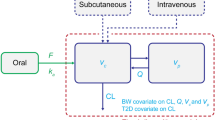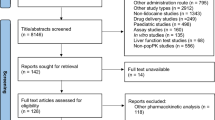Summary
Based on the well known linear relationship between the overall drug elimination rate constant and the endogenous creatinine clearance, it is shown how individual drug elimination parameters in patients with renal disease can be estimated from the patient’s creatinine clearance or serum creatinine concentration.
By means of a simple nomogram the elimination rate fraction is determined which describes the elimination rate of the drug as a fraction of its normal elimination rate constant. Based on the estimated elimination rate fraction the dosage regimen in the patient with renal disease is individually modified according to pharmacokinetic principles. At present the described method can be used with 45 different drugs.
Similar content being viewed by others
References
Baethke, R.; Golde, G. and Gahl, G.: Sulphamethoxazoletrimethoprim: pharmacokinetic studies in patients with chronic renal failure. European Journal of Clinical Pharmacology 4: 233–240 (1972).
Bennett, W.M.; Singer, I. and Coggins, C.H.: A practical guide to drug usage in adult patients with impaired renal function. Journal of the American Medical Association 214: 1468–1475 (1970).
Bricker, N.S.; Morrin, P.A.F. and Kime, S.W.: The pathologic physiology of chronic Bright’s disease. American Journal of Medicine 28: 77–98 (1960).
Bulger, R.J. and Petersdorf, R.G.: Antimicrobial therapy in patients with renal impairment. Journal of Postgraduate Medicine 47: 160–165 (1970).
Chiou, W.L. and Hsu, F.H.: A new simple and rapid method to monitor the renal function based on pharmacokinetic consideration of endogenous creatinine. Research Communications in Chemical Pathology and Pharmacology 10: 315–330 (1975).
Cutler, R.E. and Orme, B.M.: Correlation of serum creatinine concentration and kanamycin half-life. Journal of the American Medical Association 209: 539–542 (1969).
Dettli, L.: Individualization of drug dosage in patients with renal disease. Medical Clinics of North America 58: 977–985 (1974).
Dettli, L.: Drug dosage in renal disease. Clinical Pharmacology and Therapeutics 16: 274–280 (1974a).
Dettli, L.: Calculation of dosage regimens in patients with renal disease based on incomplete pharmacokinetic data. International Symposium on Clinical Pharmacy and Clinical Pharmacology, Boston. In press (1975).
Dettli, L. and Spring, P.: The modifying effects of physiological variables and disease upon pharmacokinetics. Proceedings of the 5th International Congress on Pharmacology 3: 165–173 (1973).
Dettli, L.; Spring, P. and Habersang, R.: Drug dosage in patients with impaired renal function. Postgraduate Medical Journal 46 (Suppl.): 32–35 (1970).
Dettli, L.; Spring, P. and Ryter, S.: Multiple dose kinetics and drug dosage in patients with kidney disease. Acta Pharmacologica et Toxicologica Scandinavica 29 (Suppl. 3): 211–224 (1971).
Fabre, J.: Comment prescrire les médicaments en présence de fonctions rénales déficientes? Schweizerische Medizinische Wochenschrift 102: 251–256 (1972).
Gibaldi, M. and Perrier, D.: Drug elimination and apparent volume of distribution in multicompartment systems. Journal of Pharmacuetical Sciences 61: 952–954 (1972).
Jackson, E.A. and McLeod, D.C.: Pharmacokinetics and dosing of antimicrobial agents in renal impairment. American Journal of Hospital Pharmacy 31: 36–52 (1974).
Jelliffe, R.W. and Jelliffe, S.M.: A computer program for estimation of creatinine clearance from unstable serum creatinine levels, age, sex, and weight. Mathematical Biosciences 14: 17–24 (1972).
Koup, J.R.; Jusko, W.J.; Elwood, Ch.M. and Kohli, R.K.: Digoxin pharmacokinetics: Role of renal failure in dosage regimen design. Clinical Pharmacology and Therapeutics 18: 9–21 (1975).
Krueger-Thiemer, E.: Dosage schedule and pharmacokinetics in chemotherapy. Journal of the American Pharmaceutical Association (Scientific Edition) 49: 311–313 (1960).
Kunin, C.M.: A guide to use antibiotics in patients with renal disease. Annals of Internal Medicine 67: 151–158 (1967).
Oe, P.L.: Antimicrobial therapy and renal failure (Beecham Research Laboratories, Amsterdam 1974).
O’Malley, K.; Velasco, M.; Pruitt, A. and McNay, J.L.: Decreased plasma protein binding of diazoxide in uremia. Clinical Pharmacology and Therapeutics 18: 53–58 (1975).
Reidenberg, M.M.: Renal function and drug action (Saunders, Philadelphia 1971).
Reidenberg, M.M.; Odar-Cederlös, I.; von Bahr, C.; Borga, O. and Sjöqvist, F.: Protein binding of diphenylhydantoin and desmethylimipramine in plasma from patients with poor renal function. New England Journal of Medicine 285: 264–267 (1971).
Siersback-Nielsen, K.; Molholm Hansen, J.; Kampmann, J. and Kristensen, M.: Rapid evaluation of creatinine clearance. Lancet 2: 1133–1134 (1971).
Spring, P.: Simple ‘rules of thumb’ for the dosage adjustment of gentamicin and cephalosporins in patients with renal disease. Proceedings of the 8th International Congress of Chemotherapy 2: 773–775 (The Hellenic Society for Chemotherapy, Athens 1974).
Spring, P.: Calculation of drug dosage regimens in patients with renal disease: A new nomographic method. International Journal of Clinical Pharmacology and Biopharmacy 11: 76–80 (1975).
Tozer, Th.N.: Nomogram for modification of dosage regimens in patients with chronic renal impairment. Journal of Pharmacokinetics and Biopharmaceutics 2: 13–28 (1974).
Wagner, J.G.: Biopharmaceutics and relevant pharmacokinetics (Hamilton Press, Hamilton 1971).
Wagner, J.G.: Relevant pharmacokinetics of antimicrobial drugs. Medical Clinics of North America 58: 479–492 (1974).
Welling, P.G.; Craig, W.A.; Amidon, G.L. and Kunin, C.M.: Pharmacokinetics of cefazolin in normal and uremic subjects. Clinical Pharmacology and Therapeutics 15: 344–353 (1973).
Welling, P.G.; Craig, W.A. and Kunin, C.M.: Prediction of drug dosage in patients with renal failure using data derived from normal subjects. Clinical Pharmacology and Therapeutics 18: 45–52 (1975).
Author information
Authors and Affiliations
Rights and permissions
About this article
Cite this article
Dettli, L. Drug Dosage in Renal Disease. Clin Pharmacokinet 1, 126–134 (1976). https://doi.org/10.2165/00003088-197601020-00004
Published:
Issue Date:
DOI: https://doi.org/10.2165/00003088-197601020-00004




